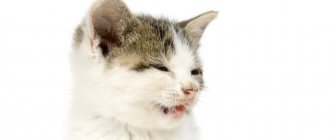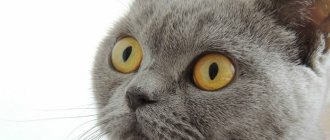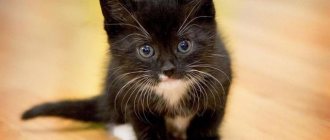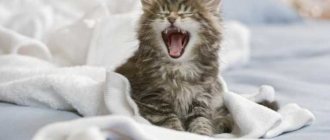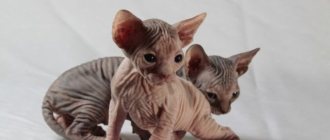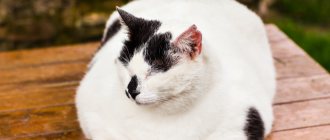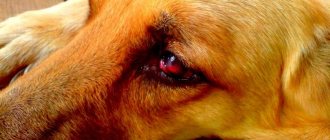9520Administration
All cats sneeze from time to time and, I must admit, it looks pretty funny. However, if a kitten is sneezing and its eyes are watery, this combination of symptoms should cause concern rather than a smile in its owner.
The causes of sneezing in a kitten can be different. The most common are:
- Various infectious diseases;
- Allergic reaction to any irritant;
- Injury or foreign bodies in the nose
It can be extremely difficult to independently determine the exact causes of a pet’s illness and can only be done by a specialist.
© shutterstock
Therefore, if your kitten begins to sneeze very often and his eyes are very watery, it is better to immediately contact a veterinarian.
There are situations in which it is impossible to get immediate qualified help. In this case, you can try to alleviate your pet’s condition by using our advice.
When is a cat's tearing normal?
global $ads_google;
//data-ad-slot=”2475549904″ $ads_google = empty($ads_google) ? false : true; ?> if ($ads_google == false) {?> $ads_google = true; ?> } ?> In some breeds of pets, the structure of the skull and visual analyzer contributes to the accumulation of tears in the corners of the eyes. This feature is observed among the Persians, British, Sphinxes and Scots. In the latter, the short and at the same time wide lacrimal canal does not retain tears, so they cover the surface of the eyeball. In Persian cats, this feature is explained by a curved duct.
If your cat's eyes are watery, but they remain clear and clean, this can be considered normal. Problems also do not arise if, in parallel with tearing, there is natural pigmentation of the iris, the eyelids are not swollen, and the liquid itself does not contain any admixture of blood or pus. When in full health, the pet does not squint, rub its eyes or sneeze. In some cases, tears appear during feeding. Veterinarians explain this fact by saying that the movement of the jaws when chewing food stimulates the functioning of the lacrimal glands.
Increased tear production is observed in older cats who, due to their age, find it difficult to care for themselves. This task must be taken on by the pet owner.
Intrabreed diseases
The most serious diseases of Maine Coons are hereditary, so the selection of breeding animals must be very careful. The most dangerous hereditary diseases among representatives of this breed are:
- Hypertrophic cardiomyopathy. The cause of this disease is hardening of the heart muscle, which can lead to embolism or complete cardiac arrest. The disease is caused by a disorder in the genes that produce a protein that helps stimulate heart contraction.
- Spinal muscular atrophy is a severe hereditary disorder in which spinal cord neurons die and muscle tissue is destroyed.
- Hip dysplasia. This disease is not life-threatening for the animal, but it turns the pet into a disabled person and is accompanied by lameness, pain and frequent dislocations.
- Polycystic kidney disease. This disease is congenital in nature, in which the kitten is born with cysts in the kidneys. As they grow, they can lead to disruption of the functioning of organs, and then to their complete failure.
No treatment for hereditary diseases can completely restore a cat’s health, so it is very important to identify animals carrying the disease and exclude them from breeding.
Diagnosis of a cat with lacrimation
To correctly diagnose a possible disease, you should observe the cat. Sometimes eye problems are accompanied by behavioral changes. Decreased activity and refusal to eat may confirm the presence of the disease. During a visual inspection it is necessary to determine:
- both eyes or only one are affected;
- how often does tearing occur?
- how much tears are produced;
- what is the purity and color of the eyeball;
- whether there are traces of blood or pus in the liquid;
- whether the mucous membranes and eyelids swell;
- Is there a prolapse of the third eyelid?
To find out the reason why your animal's lacrimation occurs, you should carefully examine the organ of vision. Before doing this, first wash your hands or wipe them with a disinfectant solution. The cat's eyes are washed to remove secretions and examined by gently pulling back the lower eyelid. Based on the diagnostic results, a clinical picture is drawn up. Signs of eye problems are determined by the condition of the visual organ and the nature of the discharge.
global $ads_google; //data-ad-slot=”2475549904″ $ads_google = empty($ads_google) ? false : true; ?> if ($ads_google == false) {?>
$ads_google = true; ?> } ?>
If a cat sneezes and tears flow
The cause of excessive tearing may be due to a bacterial, fungal or viral infection. At the same time, the cat sometimes coughs, sneezes and watery eyes. With such a problem, diseases of the respiratory system cannot be ruled out. The animal is tested for mycoplasmosis and chlamydia. With a weakened immune system, the disease can last more than a week. Another reason why a cat has watery eyes, coughing and sneezing is an allergy.
If the tears have a brown discharge
The brown color of tear fluid is due to the presence of dark-colored pigments in it. There are several reasons for this lacrimation. Some cats have brown tears because they have a short, narrow tear duct. A growing tumor can lead to a narrowing of the canal. But the anatomical structure of the organ is not always the culprit. In some cases, dark liquid accumulates due to infection of the body with worms or non-infectious inflammation of the lacrimal sac. Another reason is trauma, due to which blood enters the tear secretion.
Tears and purulent discharge
If the eyes water and pus is released, then bacterial conjunctivitis, blepharitis or keratitis is diagnosed. Sometimes the disease is aggravated by a viral infection, chlamydia. If the cat suffers from allergies, the inflammatory process is aggravated. The discharge may have a yellow, greenish, or light brown tint.
Red eyes and watery eyes
The cause of reddening of the whites with excessive tearing may be an organ injury or a foreign body getting under the eyelid. If both facts are not established during the examination, the option of allergies or increased intraocular pressure is considered. With these problems, the blood vessels often dilate and the eyes water. The cat blinks frequently, squints and avoids light.
global $ads_google; //data-ad-slot=”2475549904″ $ads_google = empty($ads_google) ? false : true; ?> if ($ads_google == false) {?>
$ads_google = true; ?> } ?>
The cat has one eye that is watery and swollen
If the problem affects only one eye, the most likely cause is mechanical damage to the organ. This could be an injury due to a blow or a sharp object getting under the eyelid. Also, the cat's eye waters and swells with unilateral conjunctivitis or glaucoma. The last problem is accompanied by a painful effect and disorientation of the pet in space. When diagnosing unilateral lacrimation and edema, it is necessary to exclude a tumor.
Tearing and cloudy eyes
If your cat's eyes are watery and cloudy, the cornea and lens need to be examined. If the color of the clouding is whitish or light blue, and the spot itself is matte, then the pathology is most likely associated with the cornea. If in the light, along with a decrease in the size of the pupil, the cloudy spot decreases, then the problem is related to the lens. Potential causes of turbidity and lacrimation are also infections, organic inclusions, scars, and vascular proliferation.
Diagnostic methods
At home, it is difficult to determine the exact cause of the cat’s deterioration. You need to seek help from a veterinarian . During the diagnosis, the animal is examined, body temperature is measured, and an anamnesis is collected by interviewing the cat's owner.
The following studies are prescribed:
- general and biochemical blood test;
- Analysis of urine;
- taking swabs from the nasal cavity and throat;
- nasal endoscopy;
- X-ray of the head.
External factors of tearing eyes
In addition to internal reasons associated with diseases and features of the anatomical structure of the visual analyzer, there are external factors that increase tear production. Conventionally, they can be divided into two groups. The first is foreign objects trapped under the eyelid. A cat cannot always remove specks, dust, and dirt on its own. Sharp objects can mechanically injure the eye. If foreign particles linger on the mucous membrane, they cause itching, redness, and inflammation. Increased tear production in such a situation is a physiological reaction of the body. The liquid helps to wash out foreign matter.
The second group of irritants does not reach the mucous membrane directly. Tear secretion begins under the influence of volatile compounds contained in the air. The reason may be the aromatization of the room, chopping onions, the release of an increased amount of natural gas, smoke from cigarettes or a fire. There is no need to treat the cat, just rinse the eyes with saline solution.
Possible reasons
One of the most common reasons for the development of such symptoms is an allergic reaction. Irritants can be:
- household chemicals;
- tobacco smoke;
- fungus on tiles and other surfaces;
- perfume, hairspray, nail polish;
- sprays used in the fight against flies, mosquitoes, and other insects;
- dust;
- cat litter;
- plant pollen.
Tearfulness accompanied by sneezing occurs due to other reasons:
- foreign body in the eye;
- injury;
- failure to comply with pet care rules;
- features of the anatomical structure of the organs of vision;
- various pathologies;
- infections.
Possible diseases
You can tell that a kitten is sick by looking at its condition. The animal's behavior changes dramatically, the pet becomes lethargic and passive.
The reason for this may be:
- colds (runny nose leads to sneezing, watery eyes);
- asthma;
- rhinitis;
- conjunctivitis;
- helminthic infestation;
- neoplasms, polyps;
- pathology of teeth, gums;
- immunodeficiency;
- rhinotracheitis;
- malignant processes.
Infectious causes
The cause of the deterioration of the cat’s condition may be an infectious disease that must be identified promptly, because a sick animal can infect other pets.
Pathologies that cause sneezing and tearing:
- Herpesvirus (infectious rhinotracheitis). Against the background of the disease, there is a risk of developing ophthalmological problems. The pet's condition can rapidly deteriorate.
- Mycoplasmosis, chlamydia. Treatment of these diseases begins immediately after diagnosis.
Causes of sneezing and tearing in one eye
Among the reasons why a cat sneezes, but only one eye is watering, are the following:
- eye injuries;
- ingress of smoke, chemicals, caustic vapors;
- narrowing of the tear duct;
- entropion of the eyelid;
- helminthic infestation;
- congenital ocular abnormalities;
- conjunctivitis.
This is interesting: What to do if a cat has a tumor on his neck?
Allergic reaction
With reduced immunity, a cat may experience increased sensitivity to certain substances. This could be new food, natural products, tray filler, medications, volatile compounds. The body's response to the irritant is expressed in the form of allergic conjunctivitis. The cat's eyes become watery, the edge of the eyelids or eyeball turns red, and swelling appears. Sometimes there are accompanying behavioral symptoms: lethargy, apathy, loss of appetite. The animal may sneeze.
global $ads_google; //data-ad-slot=”2475549904″ $ads_google = empty($ads_google) ? false : true; ?> if ($ads_google == false) {?>
$ads_google = true; ?> } ?>
If the tear secretion is clean, without questionable inclusions, then the allergy is treated with antihistamines. But the main thing in such a situation is to identify the allergen and eliminate it from the life of your furry pet. Otherwise, it will be difficult to solve the tear problem with treatment alone.
What to do
The cat’s body, or rather its protective function, is arranged as follows: to any irritant there is an immediate response, which gives a signal that some kind of deviation has occurred in the cat’s body. Sneezing and the flow of tears in a cat may indicate that some foreign object has entered the eye, or may also signal the occurrence of a serious illness. One way or another, if you notice these signs in your pet, you should carefully observe it for some time. And if the presence of mechanical damage to the eyes and nasopharynx is not confirmed, and in addition the cat becomes lethargic, its appetite worsens, its nose becomes hot, a cough appears, and the temperature rises, you should immediately take the cat to the veterinarian to find out the reasons.
Change of teeth in Maine Coons
At approximately four months of age, kittens replace their baby teeth with permanent ones. This process can cause some discomfort to the animal and affect its behavior. Therefore, many owners mistake signs of tooth change for symptoms of disease.
The kitten may become restless, refuse to eat, and become restless. Owners should not worry, as these symptoms pass quickly and do not cause harm to the pet’s health. It is enough to make sure that there is no inflammation at the site of the fallen teeth.
When to see a veterinarian
It can be difficult to determine the cause of lacrimation without the help of a veterinarian. The situation is aggravated if the eyes not only water, but also become inflamed. If there is any doubt, a specialist examination is necessary. An indication for a visit to the clinic may be if:
- lacrimation continues for more than a day;
- a foreign object was found on the mucous membrane;
- there is pus or blood in the discharge;
- eyelids and mucous membranes are swollen and red;
- noticeable obvious clouding of the cornea;
- prolapse of the third eyelid was detected;
- the cat squints or does not open its eyes;
- nasal discharge appeared;
- The animal has a fever.
Even if the listed symptoms do not overlap, and only one of them is noted, you should not postpone a veterinary examination. When a cat's eyes are watery, help should be immediate. The pet’s vision and overall well-being depend on the owner’s timely reaction.
Associated symptoms
Deterioration of the condition is accompanied by the following symptoms:
- hot nose;
- temperature increase;
- apathy;
- weakness;
- loss of appetite;
- sometimes blood comes from the nose;
- a sharp decrease in body weight;
- ulcerations, skin rash;
- purulent discharge from the eyes, nasal passages;
- breathing is accompanied by whistling, wheezing;
- cough;
- gagging;
- diarrhea.
These signs indicate the development of a serious illness. Immediate veterinary assistance is needed.
Why do Scottish Fold cats have watery eyes?
global $ads_google; //data-ad-slot=”2475549904″ $ads_google = empty($ads_google) ? false : true; ?> if ($ads_google == false) {?>
$ads_google = true; ?> } ?>
Breeders and cat lovers know that Scottish kittens and adult pets often have watery eyes. In childhood, this symptom is more pronounced than in adulthood. The anatomical structure of the head and eyes of these cats has special differences. The canal coming from the lacrimal gland is shortened, so tears do not linger in the ducts and quickly come out. The predisposition is explained by the flattened shape of the skull, which determines the non-standard structure of the ocular analyzer.
Scots' eyeballs are large, so they require regular washing with tear fluid. Otherwise, the cat is at risk of drying out the cornea. At the same time, cats that show suspicious signs must be examined, since eye diseases are no less common in them than in other breeds.
Necessary treatment
If the owners notice that the cat’s eyes often fester, he coughs and behaves strangely, then it is worth consulting with a veterinarian to rule out or confirm the disease. The specialist will first examine the sick kitten. If it is not possible to visually determine the source of the problem, then diagnostic procedures are required, such as:
- blood analysis;
- laboratory testing of urine;
- diagnostics of discharge to identify pathogenic microorganisms.
Since a cat has snot and watery eyes due to various pathological factors, treatment is selected individually for each animal. Often the source of the problem lies in the entry of a foreign object into the nasal passages, which must be removed independently using tweezers or forceps or in a veterinary clinic.
If the owners are not confident in their own abilities and doubt that they will be able to independently remove a foreign body from the kitten’s nose or mouth, then they turn to a specialist. If the manipulation is carried out carelessly, there is a high risk of damage to blood vessels or mucous membranes, which will lead to complications.
What medications are allowed?
Drug treatment is aimed at eliminating symptoms and strengthening the pet's immune system.
When the eyes run and the kitten sneezes due to an infectious disease, complex drug therapy is prescribed. The pet is prescribed eye and nasal drops and other medications that must be used in the dosage strictly specified by the veterinarian. It is important to eliminate unpleasant symptoms in the kitten and strengthen the immune system so that the disease does not recur. The following medications are popular with anti-inflammatory, antiseptic and immunostimulating effects:
- "Anandin";
- "Maksidin";
- "Timogen".
If there is no positive dynamics, then other means are prescribed that need to be used under the supervision of a specialist:
- "Naphthyzin";
- "Dioxidin";
- "Derinat";
- "Galazolin."
When injecting drugs into the eyes, care must be taken not to damage the kitten's mucous membrane and cause complications. First, the pet’s eyelid is pulled back and medicine is dripped at a distance of 2 centimeters. After the manipulation, it is recommended to stroke and calm the animal, hold it in your arms for 5 minutes so that the product is well absorbed. It is worth purchasing a small treat in advance and giving it to the kitten after successful procedures.
Treating Cats' Watery Eyes at Home
If a cat has been diagnosed with an eye disease, it must be treated urgently. The method and duration of treatment depends on the type of problem. If it is infectious, it is necessary to wash the eyes with an antibacterial solution to remove any remaining secretions and purulent discharge. Furacilin (0.2%), an infusion or decoction of medicinal herbs (chamomile, calendula, string, oak bark), and brewing black or green tea are suitable for this purpose.
If an infusion of herbs is used for rinsing, it should be filtered through several layers of gauze. The disinfectant solution is taken slightly warm. The washing technique consists of several steps. The cat is wrapped in a blanket and, if necessary, the help of a second person is used. An antiseptic solution is instilled into the outer corner of the eye. After 2-3 minutes, when the dried discharge has become wet, wipe the eye with a cotton pad soaked in the solution in the direction from the outer corner to the inner.
After the eyes have been washed, the medicine is instilled or ointment is placed under the eyelid. To treat tearing, drops of Levomycytin, Sofradex, Kanamycin, Lakrikan, Tsiprovet are used. The product is instilled 3-5 times a day into both eyes (even if one is damaged). The cat is treated in this way for two weeks. Instead of drip antibiotics, you can use an effective ointment, for example, Solcoseryl.
It is not recommended to put corticosteroids into the eyes of cats!
With the help of drugs
When an animal sneezes and its pupils are watery, the doctor suggests treatment with the following means:
- Anandin. This medicine helps in rapid healing of wounds and has antimicrobial effects;
- Maxidin. Has good immunostimulating properties. May help with inflammation of the eyes and rhinitis;
- Thymogen. This is a drug that regulates the immune system.
If no positive trends are observed, then, on the recommendation of a doctor and under his supervision, the following pills should be taken:
- Naphthyzin. It comes in the form of nasal or eye drops. Has the property of constricting blood vessels and has an antiphlogistic effect;
- Dioxidine. It is used for purulent rhinitis and has disinfectant properties;
- Derinat. Helps strengthen the immune system, used mainly for rhinitis and conjunctivitis;
- Nazivin. It comes in the form of drops: both for the nose and for the eyes. Used to reduce inflammation in these areas.
If the cat has a serious illness, then the following medications are prescribed:
- Drops "Diamond eyes". They have an antimicrobial and regenerating effect thanks to components such as chlorhexidine, sodium succinate and taurine;
- Furacilin. It is contained in the drug "Bars", which fights microbes well. Novocaine, which is part of it, anesthetizes. Prescribed for severe keratitis;
- “Iris” is the name given to the drops that are used to treat a corneal ulcer. The composition contains the antibiotic gentamicin and many healing elements;
- To treat inflammation of the conjunctiva, Ciprovet is used, which contains the antibiotic ciprofloxacin.
Cat Eye Care: Preventing Tears
In order not to have to find out the reason why your cat’s eyes are watery and not resort to treatment, it is necessary to constantly engage in the prevention of eye diseases. This is especially true for purebred kittens that have a genetic predisposition.
global $ads_google; //data-ad-slot=”2475549904″ $ads_google = empty($ads_google) ? false : true; ?> if ($ads_google == false) {?>
$ads_google = true; ?> } ?>
If your cat’s eyes water for natural reasons, then for hygienic care it is enough to periodically wash them with a physiological or disinfectant solution. In case of abundant natural discharge, the procedure is carried out twice a day: in the morning and in the evening. This hygienic treatment is suitable for the prevention of eye diseases in cats of all breeds.
The complex of preventive measures includes systematic treatment against helminths and ectoparasites. To prevent a long-haired cat from having watery eyes, she needs grooming. Long hairs can touch the eyeball and stimulate tearing. To exclude chronic diseases and infections that provoke eye diseases, the pet should be protected from hypothermia, vaccinated on time and fed with nutritious food.
All accessories and tools for processing (swabs, pipettes, syringes, containers) must be perfectly clean.
Prevention
The protective functions of a cat’s body are capable of repelling any infection, but only if it has a fairly good and strong immune system. To maintain the natural strength of the animal, it is necessary to treat it carefully and provide it with proper care.
For prevention purposes, you can take the following measures:
- Provide your pet with a balanced diet;
- Try to ensure that there are no drafts in the apartment;
- Do not allow your cat to walk for a long time when it is cold outside;
- Rinse your cat's eyes regularly with herbal decoctions.
If suddenly your cat begins to sneeze frequently and her eyes are watery, you should not be alarmed ahead of time, but you should not delay treatment either. Perhaps the cat has a cold or has some other illness. In any case, it is best to show it to a specialist to find out the exact cause and provide your furry pet with the necessary help.
How to diagnose the disease yourself
You can independently identify the viral nature of the disease by the following symptoms:
- a sharp deterioration in health, prolonged sleep is not typical;
- loss of appetite;
- increased body temperature;
- snoring in sleep, bad breathing;
- nasal congestion, clear or mucous exudate may flow from it;
- the eyes begin to water, often the condition is complicated by conjunctivitis;
- Due to the movement of snot along the respiratory tract, a cough occurs.
If the above symptoms are supplemented by an elevated body temperature for more than 3 days and the presence of green snot, this indicates a bacterial infection.
With allergic rhinitis and conjunctivitis, the animal constantly sneezes and coughs, and its eyes water. The condition can last for many months with constant contact with the allergen.
Important! You can only suspect a pathological process on your own, but in order to confirm it and get the right treatment, it is better to consult a doctor who will conduct instrumental and laboratory tests.
Main problems
There are many conditions characterized by sneezing and watery eyes, but some are diagnosed more often than others. It is worth considering them separately. If other significant symptoms are present, pathology can be identified and treated.
How to tell if your cat has a cold
The cause of the disease is hypothermia of the pet. This is facilitated by a sharp temperature change. To do this, your pet just needs to play actively and then go outside during the cold season.
Swimming in cold water, jumping in the snow, and staying in the rain also contribute to the development of colds.
Characteristic features:
- cough;
- lethargy;
- conjunctivitis;
- temperature increase, but insignificant;
- lack of interest in food;
- snot.
Important! Cold symptoms are in many ways similar to other more serious pathologies, and if in doubt, you should visit a veterinarian and clarify the diagnosis.
To recover, you need to provide your pet with peace, warmth and rest. It is recommended to periodically wash your eyes and nose with a cotton swab dipped in clean water at a comfortable temperature.
If the provoking factor is reduced immunity, then it is recommended to use vitamins and immunomodulators as agreed by the veterinarian. A cold goes away within 5-7 days.
Symptoms of laryngitis
The disease is characterized by inflammation of the mucous membrane of the mouth and larynx.
The cause of development is hypothermia of the throat
The cause of development is hypothermia of the throat as a result of eating cold food from the refrigerator or water, as well as after a long stay outside in winter or exposure to acrid smoke.
Symptoms:
- dry, hysterical cough, gradually turning into a wet one;
- swelling of the oral mucosa;
- foamy discharge from the mouth after a prolonged cough;
- restless sleep;
- wheezing.
To treat laryngitis, various medications are used depending on the cause of development. Only a veterinarian will prescribe an adequate course of therapy.
Attention! Laryngitis can be a sign of deadly viruses such as rabies, so you should see a doctor if these symptoms appear.
Rhinitis in cats
The pathological process develops against the background of hypothermia, allergies, parasites and various infections. At the same time, the cat has difficulty breathing and constantly opens his mouth.
How to carry out the procedure?
It is very important to hold the cat well with a towel during any medical procedure. Because any sudden movement of the pet can cause even more harm to it.
How to do it? First you need to prepare the place for burial. It is wiped with a cotton pad previously moistened with the necessary solution. Dried purulent discharge softens and is easily removed.
The next step is to take the following steps:
- prepare medications;
- pull back the eyelid;
- instill the drug;
- after penetration of the medicine, the cat should remain motionless for about 5 minutes for good absorption of the medicine;
- pet the cat and give him treats.
Symptoms
The symptoms that accompany those moments when the pussy sneezes can be very diverse depending on the severity and type of infection:
- The eyes are slightly swollen, slight lacrimation.
- Due to prolonged watering, the hair around the eyes may begin to fall out, leading to eczema or dermatitis.
- The consistency of eye discharge can vary from liquid to thick.
- Dry accumulations in the corners of the eyes are brown in color.
- Irritation appears. The kitten rubs its eyelids with its paws or other objects, which can cause harm to it.
- The redness and inflammation caused by conjunctivitis extends beyond the eye.
- With long-term lacrimation, the cat's condition may worsen, the temperature may rise, and the cat may even be afraid of lighting.
If you start these symptoms, the pet will get worse and worse. You can't do this without a veterinarian. The doctor will answer the question why your pet is sneezing and prescribe the necessary medicine.
